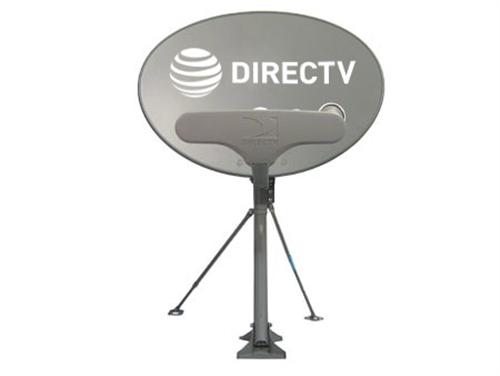Satellite TV is a familar part of our world. It has been for decades. Chances are if you don’t have a dish on your roof, someone in your neighborhood does. Between DIRECTV and DISH, there are close to twenty million satellite TV subscribers, meaning close to one in ten homes is getting television service from the sky. That’s a pretty impressive success rate for an industry that barely existed twenty years ago.
But, do you really know what satellite TV is an how it works? Here’s a really loose primer. Some of the hardcore experts may disagree with some of my generalities, but I think this will help someone who just wants an idea how it all works on a basic level.
What does “satellite television” even mean?
Satellite television means any live video service supplied via earth-orbiting satellite, and can be loosely separated out into four categories: Free-to-Air (FTA), FreeView, Direct Broadcast Satellite (DBS), and private networks. While the basic technologies for both are the same, one has become largely extinct while others have dominated. Let’s look a little closer at what makes satellite TV work.
Geostationary satellites
There’s a formula that tells us how quickly an object is going to go around the earth, and it has to do with how close it is. As something is closer to the earth, gravity pulls it faster and faster, while further objects travel around the earth slowly. The International Space Station goes around the earth every 92 minutes, while the moon, which is much further away, makes the trip in about 29.5 days. The sweet spot for communications satellites is roughly 22,000 miles above mean sea level. At that distance an orbit of the earth takes exactly one day, meaning the satellite seems to hang in space above a particular point on earth.
When a satellite is fixed in space relative to the earth, a dish can point to it and it s a fairly simple matter to broadcast signals up to it and have them bounce down much like making a bank shot in pool. That’s the basis of all satellite TV: signals go up, signals come down.
Free to air
The term “Free to air” means satellite transmissions that are completely unencrypted. This form of satellite TV was very popular in the 1980s but has almost completely disappeared today. Free to air transmissions require a motorized dish that points at many different satellites, one at a time, and requires you (or your computer) to know what is on each satellite. It’s not a very efficient way to watch TV, but back when premium channels sent their programs up to satellites without any encryption, it was pretty popular.
Free to air systems have been almost completely replaced by streaming, which offers much of the same content without the large expense of a dish or the technical knowhow required to get the programs you want.
FreeView
FreeView satellite, seen almost exclusively in Europe and the Middle East, is a version of FTA that uses the same dishes you’re used to seeing. The difference is that itis free to residents (or is part of the same tax structure that brings over-the-air TV.) The technology is the same as we see here in the US but without encryption. There are practically no FreeView satellite systems in the Western Hemisphere. Here, DIRECTV and other providers have pushed countries to adopt the paid model instead.
Direct Broadcast Satellite
The term “Direct Broadcast Satellite” describes a service where a master system operator (like DIRECTV or DISH) collects a lot of different programs, beams them all up to the same satellite, and collects a fee for letting you watch them. DBS has become popular since it acts like traditional pay TV.
DBS was designed from the start to be customer-friendly. The goal was a digital service that used a dish no larger than 20″ high and did not need to be reaimed for every program. I
t was felt that the large size and technical complexity of FTA dishes made them unpopular. In exchange for developing the technology to make dishes smaller and easier to use, governments around the world granted satellite TV companies the right to encrypt their signals, making it possible to charge customers for decryption.
Encryption
Encryption is the key to modern satellite TV, because the process of building all the land-based and sky-based parts of a satellite TV system is incredibly expensive. If anyone could put up a satellite dish and get free TV, there would be no reason for companies to invest so heavily. Both DIRECTV and DISH have put millions of dollars into encryption schemes that have managed to stay one step away from hackers for decades, no small feat.
Private Networks
Since practically the very start, DBS companies have leased out some of their channels to other companies. They can be used for company-wide communications, training videos, or literally anything the company wants. The technology is the same as is used for consumer DIRECTV or DISH, and even uses the same receivers. The difference is that regular consumers can’t decrypt those private channels. Only the intended recipients can.
To some degree, this technology has waned since it became possible to stream video over the internet. But, it’s still out there. It’s cost-effective and more private than internet-based systems. It lacks the two-way aspect of something like Zoom. On the other hand you can have a true broadcast-quality signal.
Other forms of satellite communication
This article has really focused on satellite TV for “end users” in other words, regular folks. There is, of course, satellite communication between governments, between broadcast sites, and the like. There’s also satellite-based internet and telephone systems, which continue to improve. However, that’s a subject for another article.
…brought to you by Solid Signal
SolidSignal.com is your source for everything you need to live your best digital life, including satellite TV accessories and receivers. Shop -at Solid Signal for satellite TV! If you have a question about TV technology or anything else we sell, call us at 888-233-7563.





